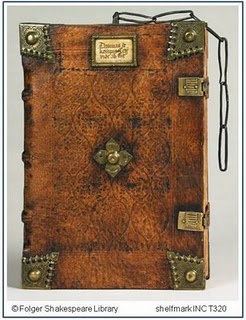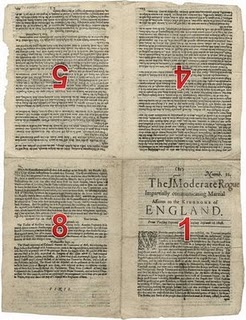The first is what I think of as a book with a seriously material presence: Thomas a Kempis’s Works printed in Nuremburg in 1494 and bound in a contemporaneous pigskin binding with beautiful blind tooling, heavy brass corner bosses, clasps, and an iron chain.

Now that’s a book! And not one you could take with you on your travels, either. But, of course, that is one of the reasons it has survived: it is heavily armored. (More details in our catalogue.)
My other example is its opposite, something that I find amazing it has survived at all: a newspaper from September 1648 called The Moderate (although its user has renamed it as The Immoderate Rogue). It’s just one sheet of paper, no binding, no protection, no nothing. And yet here we have it.
I like this, too, for what it shows about the early modern printing press. It’s an uncut sheet, printed in a quarto imposition. There are four pages printed on this side of the sheet of paper; flip the sheet over, and the remaining four pages are printed. What you get, once you’ve folded the sheet in the right order, is a 4-leaf (or 8-page) pamphlet. Below is the numbering for the order of this newspaper, were you to fold and cut it.
Newspapers were not designed to last through the ages. They were meant to be read and used and perhaps passed on. As with other types of popular printed material, the more heavily they were read, the fewer of them survived for us to study today. The current exhibit at the Folger focuses on the history of newspapers. It’s a hugely informative and interesting exhibit. You can see it at the Library itself through 31 January 2009; you can also check it out
online and listen to the
audio tour.



>What a beautiful book.